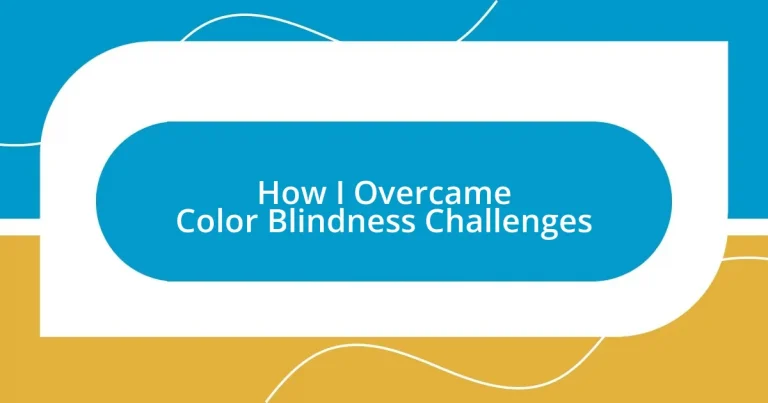Key takeaways:
- Color blindness presents unique daily challenges, affecting tasks from choosing clothing to interpreting safety signals, often leading to feelings of isolation and self-doubt.
- Utilizing tools like color identification apps and community support can significantly improve confidence and independence for individuals with color blindness.
- Engaging in personal reflection and seeking professional help, including support groups, helps address the emotional impact of color blindness and fosters a sense of belonging.
- Sharing personal experiences and encouraging open conversations can empower others facing similar challenges, highlighting the value of community and mutual support.

Understanding Color Blindness Issues
Color blindness isn’t just about seeing the world in shades of gray; it’s about navigating daily life with challenges that many people take for granted. I remember struggling during art class when the teacher asked us to pick colors for our projects. I felt isolated as my classmates excitedly discussed vibrant hues, while I was left guessing, often settling for what seemed like the less popular choices. Can you imagine how that would feel—the attempts to blend in, only to realize you’re viewing the world through a different lens?
Another issue I faced was safety signals, like traffic lights. Initially, recognizing the colors was an instinct; I navigated based on the position of the lights. But what happened during a unfamiliar drive when the colors were obscured by glare? I often found myself apprehensive at intersections, questioning whether I was stopping at red or green. This anxiety sometimes made me second-guess my choices, resulting in an overwhelming sense of doubt.
Social situations can also present their own set of challenges. My friends joked about getting dressed in “mismatched” outfits because I can’t always differentiate colors. I’d laugh along, but beneath that smile, there was a hint of frustration. How many times had I hesitated before leaving home, wondering if I was wearing something that truly matched? It wasn’t just about looking good; it was about wanting to feel confident in front of others, and that’s a struggle I suspect many can relate to.
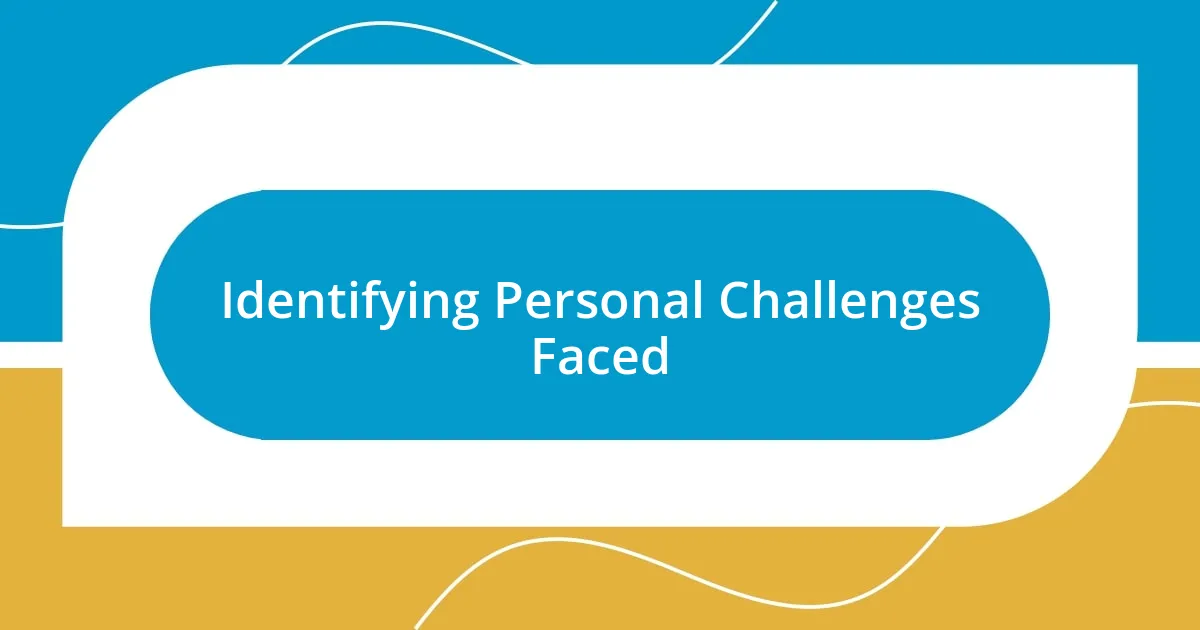
Identifying Personal Challenges Faced
Navigating the world as a color-blind individual can often feel like a continuous puzzle. I distinctly recall a moment in high school when I confidently wore what I thought was a navy blue shirt. Only later did a friend point out that it was actually black. It’s a small incident, but such moments can chip away at your self-esteem over time. How often do we associate our clothing choices with our identity? For me, it became a reflection of deeper insecurities about fitting in.
In group settings, I faced unique challenges that felt overwhelming. Picture this: a group of friends excitedly discussing the latest color trends for home decor. While they flourished with ideas of bold reds and calming greens, I sat there feeling completely lost. Even something as simple as picking a color for my own bedroom evoked anxiety. I often resorted to online color generators, trying to decipher palettes that everyone else seemed to navigate so effortlessly. The fear of ending up with an unintentional clash weighed heavily on my mind.
There were also the everyday annoyances that became painfully apparent, like planning events. I once organized a birthday party and, in the midst of the preparations, I misinterpreted the theme colors. Friends arrived dressed in completely different hues, leading to a disjointed look that felt embarrassing. Learning to advocate for myself in these situations was essential. It made me realize that effective communication could bridge the gap, but it took a lot of practice to feel comfortable asserting what I needed.
| Challenge | Description |
|---|---|
| Misidentifying Colors | Confusion during clothing choices, leading to embarrassment. |
| Social Interaction | Feeling excluded when discussions turn to color-related topics. |
| Event Planning | Struggles with coordinating theme colors for gatherings. |

Exploring Available Tools and Resources
Exploring tools and resources to cope with color blindness can be a game-changer. In my journey, I discovered several helpful options that transformed how I engage with color. For instance, using smartphone apps specifically designed for color identification not only made daily tasks easier but also significantly boosted my confidence. Each time I used one of these apps to pick paint colors, I felt a wave of relief knowing that I was making informed choices rather than guessing.
Here’s a brief overview of some effective resources I’ve come across:
- Color Identification Apps: Many apps like Color Blind Pal and ColorID can identify colors in real-time using your smartphone’s camera.
- Smart Glasses: Products like EnChroma glasses enhance color perception. I remember trying them on for the first time and being taken aback by how vibrant the world looked.
- Community Support Groups: Connecting with others who share similar challenges can provide emotional support and practical tips.
- Color-Labeling Tools: Using colored labels around the house helped me with organizing and differentiating items. Just placing a small sticker on the bottom corner of a container made all the difference.
Embracing these tools not only helped me manage my color blindness but also fostered a sense of independence I never knew I could achieve.
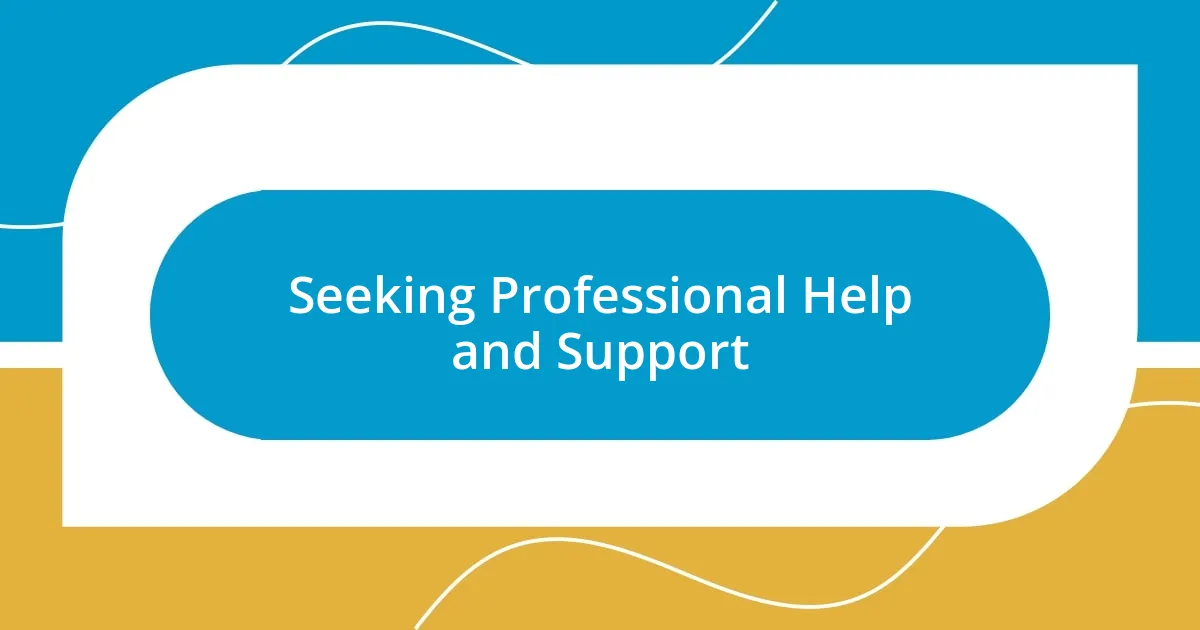
Seeking Professional Help and Support
Seeking professional help can be a pivotal step for anyone navigating the challenges of color blindness. I remember my first appointment with an eye specialist who specialized in color vision deficiencies. I walked in feeling uncertain, but the thorough evaluation opened my eyes, quite literally! It was comforting to talk to someone who understood my experiences. Have you ever felt the relief of being heard by someone who truly gets it?
In addition to finding an eye specialist, I sought support from a psychologist who helped me address the emotional facets of color blindness. It may sound surprising, but discussing my insecurities in a safe environment provided clarity. I learned to reframe my experiences as unique rather than burdensome. Have you ever noticed how speaking your truth can lighten your load?
Engaging with support groups also enriched my journey. Meeting others who faced similar challenges was refreshing. We shared practical tips—like how to navigate social situations involving color—and personal stories that resonated on a deeper level. I often left our gatherings feeling uplifted, knowing I wasn’t alone in my struggles. Isn’t it empowering to find community in shared experiences?
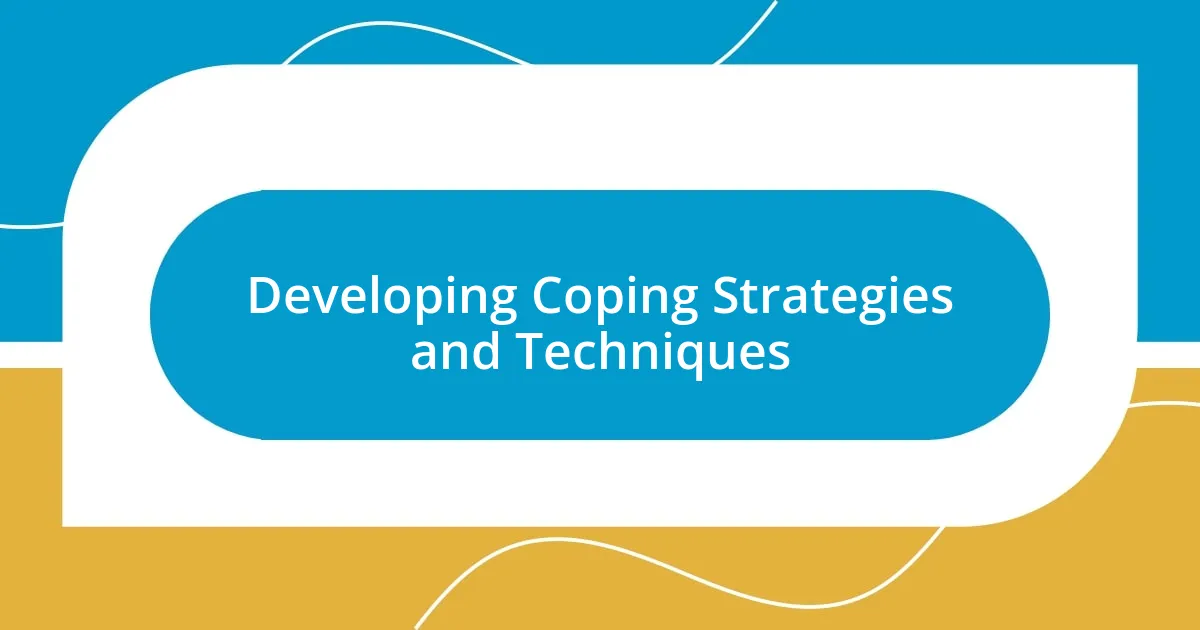
Developing Coping Strategies and Techniques
One technique that really helped me was creating a routine around color interaction. I started categorizing tasks by color, which simplified my approach to everything from dressing to decorating my living space. For example, I dedicated weekends to organizing my closet by labels that described styles rather than relying on color alone. Isn’t it interesting how breaking tasks down can make them less daunting?
Another strategy involved discovering visual mnemonics. I used familiar objects to represent colors in my mind, associating them with things I could easily visualize. For instance, I imagined ripe bananas to signify yellow and fresh strawberries for red. Having these mental cues made navigating color-related tasks more intuitive. Have you ever tried to create personal associations to simplify complexities in your life?
Lastly, embracing patience with myself was vital. In social settings where color distinctions mattered—like when choosing a restaurant based on its ambiance—I learned to speak up about my color perception. I remember feeling a mix of vulnerability and empowerment when I told my friends, “Hey, can someone help me with this?” This openness not only forged deeper connections but also alleviated that heavy pressure I used to feel. Isn’t it freeing to ask for support when you need it?
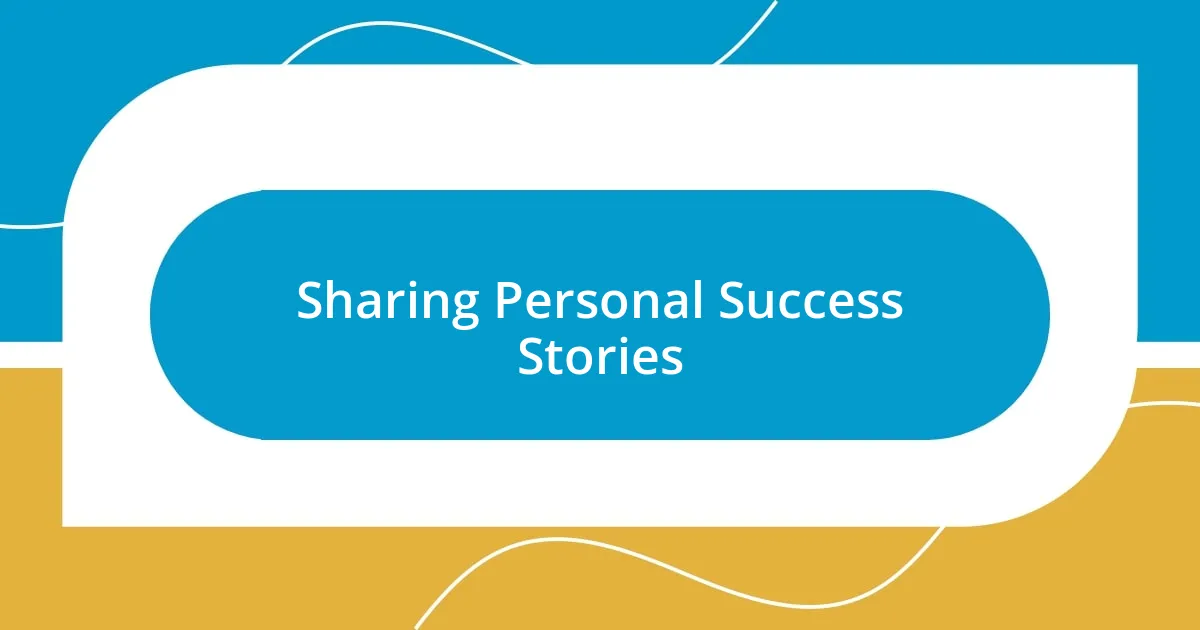
Sharing Personal Success Stories
When I think about my journey, I can’t help but recall the joy of learning about color theory. I took a course that explained how colors interact, which surprisingly sparked a creative flame in me. It felt like unlocking a treasure chest of possibilities. Have you ever experienced that moment when you finally grasp something and it changes your perspective completely?
Another success came when I volunteered for a local art program. I worked with kids, helping them express their feelings through painting. It was both humbling and uplifting to watch them create masterpieces inspired by their own interpretations of color. Was there ever a time when you realized your challenges could empower others? I found comfort in knowing that my experiences with color blindness allowed me to connect with these young artists on a different level.
Ultimately, sharing my story publicly was a breakthrough. I wrote a blog detailing my experiences, and the responses were overwhelming. So many readers reached out, sharing their struggles and victories. It was incredible to realize how my words had resonated with others. Have you considered how your own story might inspire someone else? It reinforced to me that our journeys are interconnected, weaving a tapestry of shared resilience.

Encouraging Others on Their Journey
It’s truly inspiring to connect with others facing similar challenges. I recall a time when a fellow color-blind friend shared their struggles with selecting the right clothes for an important event. I encouraged them to embrace their individuality, emphasizing that their unique perspective could actually enhance their style. Isn’t it powerful to realize that our differences can become strengths in a world obsessed with conformity?
Sometimes, a simple message can make a world of difference. Once, I wrote a note to someone who was feeling lost on their journey, urging them to document their own experiences. I shared how journaling had helped me process my emotions and track my progress. Reflecting on milestones, both big and small, can be a great morale booster, right? It’s like weaving your own narrative into a greater story of perseverance.
Moreover, I believe in the importance of asking for help. I actively remind others in the community that it’s okay to seek support when navigating color-related challenges. One day, during a small meet-up, I encouraged someone to speak up about their experiences. The silence that followed transformed into an open discussion, and I smiled as I saw their confidence grow. Wouldn’t it be amazing if we all felt empowered to share our journeys more freely?












